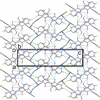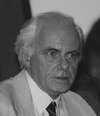issue contents
June 2023 issue

Cover illustration: Structures with more than one molecule in the asymmetric unit (Z′ > 1) are the exception rather than the rule, with the relative abundance dropping rapidly with increased Z′. The crystal structure of 5-(trifluoromethyl)-1,3,4-thiadiazol-2(3H)-one reported in this issue has Z′ = 6, estimated to occur in only about 0.05% of structures. A Hirshfeld surface analysis indicates that all six molecules have similar packing environments within the crystal structure. See: Geetha, Mohan Kumar, Anil Kumar, Shreenivas, Basavaraju, Yathirajan & Parkin [Acta Cryst. (2023). E78, 557–561].
research communications
Download citation


Download citation


The crystal structures of two benzothiophene derivatives are described along with an analysis of the intermolecular contacts in the crystals performed using Hirshfeld surface analysis and two-dimensional fingerprint plots.
Download citation


Download citation


In the crystal, the molecules are connected by N—H⋯N hydrogen bonds into dimers with an ![[R_{2}^{2}]](/e/issues/2023/06/00/vm2282/teximages/vm2282fi1.svg) (12) motif, forming chains along the b-axis direction. These chains are linked to each other by N—H⋯N hydrogen bonds, N–H⋯π and π–π interactions, forming a three-dimensional network.
(12) motif, forming chains along the b-axis direction. These chains are linked to each other by N—H⋯N hydrogen bonds, N–H⋯π and π–π interactions, forming a three-dimensional network.
CCDC reference: 2260011
Download citation


Download citation


The title aroylhydrazone ether exists in an E-configuration with respect to the double bond of the hydrazone bridge and with an acyl–hydrazone (—CH=N—NH—CO—) torsion angle of 166.0 (3)°. The molecule exhibits a non-planar conformation, likely induced by packing requirements.
CCDC reference: 2232132
Download citation


Download citation


The two polymorphic structures of 3-phenyl-1H-1,3-benzodiazol-2(3H)-one (I and II) exhibit identical bond distances and angles except for the C—N—C—C torsion angle between the benzimidazolone backbone and the phenyl substituent, which has an effect on the crystal packing and supramolecular features. The structure of I contains a stronger C=O⋯H—N hydrogen-bonding interaction and a weaker π–π interaction between adjacent bezimidazolone moieties in comparison to II.
Download citation


Download citation


The title 4-aminoantipyrine Schiff base compounds both deviate from planarity with the phenyl ring and the substituted benzylidene ring being inclined to the pyrazole ring mean plane by 54.87 (7) and 22.92 (7)°, respectively, in the first compound and by 60.44 (8) and 12.70 (9)° in the second.
Download citation


Download citation


The asymmetric unit of the title compound consists of two independent molecules differing slightly in conformation and in their intermolecular interactions in the solid.
CCDC reference: 2262070
Download citation


Download citation


1-(4,5-Dimethoxy-2,3-dinitrophenyl)-2-methylpropyl butylcarbamate, which affords butylamine on photoirradiation, was prepared by the reaction of 1-(4,5-dimethoxy-2,3-dinitrophenyl)-2-methylpropan-1-ol and butylisocyanate using dibutyltin dilaurate as a catalyst. Single crystals of the carbamate were grown in a 1:1 mixed solution of hexane and ethyl acetate. Two nitro groups and one methoxy group of the novel photo-protecting group were twisted out of the plane of the aromatic ring and intermolecular hydrogen bonds are observed between carbamate moieties.
CCDC reference: 2261578
Download citation


Download citation


The title molecules were synthesized by alkylation of 5-[(4-dimethylamino)phenyl]-1,3,4-oxadiazole-2-thiol. In the crystals, C–H⋯π interactions are observed between neighboring molecules. Hirshfeld surface analysis indicates that H⋯H and H⋯C/C⋯H interactions make the most important contributions to the crystal packing.
Download citation


Download citation


The synthesis and crystal structure of 5-(trifluoromethyl)-1,3,4-thiadiazol-2(3H)-one, a heterocycle of importance as a pharmaceutical building block, are presented.
CCDC reference: 2263179
Download citation


Download citation


The title compound can be described as a salt (HL)+(Gal)− (L = 1,3-bis(benzimidazol-2-yl)propane (L); HGal = gallic acid) co-crystallized with a neutral molecule L. The crystal also comprises disordered solvent ethyl acetate molecules.
CCDC reference: 2263401
Download citation


Download citation


In the crystal, intermolecular N—H⋯O and C—H⋯O hydrogen bonds connect molecules into chains along the b-axis direction through the dimethyl sulfoxide solvent molecule, forming C(10)![[R_{1}^{2}]](/e/issues/2023/06/00/tx2068/teximages/tx2068fi1.svg) (6) motifs. These chains are connected via S—O⋯π interactions, π–π stacking interactions and van der Waals interactions.
(6) motifs. These chains are connected via S—O⋯π interactions, π–π stacking interactions and van der Waals interactions.
CCDC reference: 2264500
Download citation


Download citation


In the crystal structure of the title compound, the packing is driven by C—H⋯F, N—H⋯O and C—H⋯π contacts. Hirshfeld surface analysis showed that the largest contribution to the surface contacts arise from F⋯H/H⋯F interactions.
CCDC reference: 2263932
Download citation


Download citation


The title compound is a phthalimide-protected polyamine with a protonated central nitrogen atom. The crystal packing features a hydrogen-bond network, a two-coordinated chloride ion, and off-set π–π stacking.
CCDC reference: 2264952

 journal menu
journal menu































